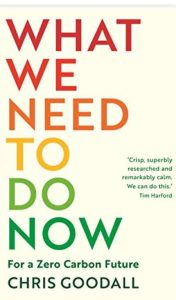What we need to do now
Chris Goodall is an English economist and writer who previously has authored several books on climate change and energy transitions, including the highly readable “The Switch” a few years back. The present book is as the title indicates a primer on how to go about with the sustainability transition in the UK. Although some parts of the analysis is specific to the UK, the general perspective, as well as the methodology, is highly relevant for other countries as well.
The message is the following. Avoiding harmful climate change is a must, and so is respecting other planetary boundaries. The perhaps most important steps in achieving are (1) to electrify everything that can be electrified (electrical cars for instance) and (2) phase out fossil fuels and substitute it with renewable energy, primarily solar and wind. This will require a vast expansion of renewables. Goodall shows that in the UK case the necessary expansion is entirely doable and at an acceptable cost: the necessary investments are calculated to be about 2% of GDP annually over period of 20 years. To handle the well known “intermittency” problem, i.e., that the sun doesn’t always shine and the wind doesn’t always blow, he suggests to increase the capacity of renewables to a level sufficient to cover the country’s needs for most days in the year (say, 90 % of the time). This implies that there would be a surplus of electricity produced most of the time, some of which may be stored in batteries (car batteries for instance) to cover fluctuations on a daily basis (night versus day, say). However, most of the surplus should according to Goodall be used to produce green hydrogen through the well established technique of electrolysis.
The perhaps most important steps in achieving are (1) to electrify everything that can be electrified (electrical cars for instance) and (2) phase out fossil fuels and substitute it with renewable energy, primarily solar and wind. This will require a vast expansion of renewables. Goodall shows that in the UK case the necessary expansion is entirely doable and at an acceptable cost: the necessary investments are calculated to be about 2% of GDP annually over period of 20 years. To handle the well known “intermittency” problem, i.e., that the sun doesn’t always shine and the wind doesn’t always blow, he suggests to increase the capacity of renewables to a level sufficient to cover the country’s needs for most days in the year (say, 90 % of the time). This implies that there would be a surplus of electricity produced most of the time, some of which may be stored in batteries (car batteries for instance) to cover fluctuations on a daily basis (night versus day, say). However, most of the surplus should according to Goodall be used to produce green hydrogen through the well established technique of electrolysis.
Green hydrogen is critical to Goodall’s strategy in several respects, particularly for conversion back to electricity in the 30-40 days of the year for which a deficit may be expected. But hydrogen’s role in substituting for fossil fuels in other parts of the economy than the electricity sector, particularly so-called hard-to-decarbonize sectors, e.g., long-haul lorries, aviation, shipping, steel, cement and fertilizers, is also of major importance. The exact technological solutions may vary somewhat from sector to sector, though. While in some instances hydrogen may substitute directly for fossil fuels, in other cases hydrogen may be the basis for producing synthetic fuels (which may be used instead of fossil fuels in e.g. shipping and aviation). While some of the required technologies for doing so are well established, others are at an experimental stage, and the costs are generally higher than existing fossil fuel alternatives, at least when the societal costs of carbon emissions are not properly accounted for (as they generally aren’t). A relatively high carbon tax, 100 USD or more, is therefore central to Goodall’s scheme.
The book also has insightful discussions (chapters) on other aspects of the transition, e.g., buildings, food/agriculture, and lifestyles. It is highly recommended.
Chris Goodall: What we need to do now – for a zero carbon future, Profile Books, 2019, 215 pages